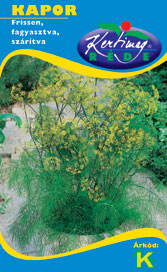Capers 3 g
| HUF 369 * (nettó: HUF 291) | |
Characteristics of dill:
An annual plant with slightly woody stems. It has a short, stalked rootstock that penetrates 40-60 cm into the soil, with lateral roots evenly distributed over the top 20-30 cm, but not too densely. Its poorly developed root system makes it sensitive to the water flow in the upper soil layer. Its cylindrical, steeply upright stems are finely grooved and can branch at any point from the root neck. Its stem length (60-140 cm) is strongly influenced by environmental factors. The lower leaves, which are scattered along the stem, wither easily. The stem and all lateral shoots terminate in terminal umbellate inflorescences.
Environmental requirements of dill:
Heat requirements:
Dill is moderately heat-hungry. Its seeds germinate at 4-5ºC, but at the optimum germination temperature of around 12-15ºC it develops many leaves and a good root system. At the stage of its development when the umbels appear on the stem tips, its heat requirements increase by 10ºC, only above 20ºC is its fruit set secure and its ripening rapid. It is less sensitive to cold. If sown early, it is not affected by possible late spring frosts.
Light requirements:
Grows well in partial shade initially. However, when flowering, it requires a lot of sunlight. It can be grown without irrigation. In spring, soil moisture is usually sufficient for seed germination and growth of the vegetative parts. It requires a lot of water during the accelerated development before the umbels appear, and this high water requirement lasts throughout flowering, then decreases again at maturity. As a second crop, it can be grown safely only by irrigation, and drip irrigation is particularly important.
Soil requirements:
Less sensitive to soil. It can be grown almost anywhere. It is ideally suited to easily warmed, well-watered, medium loam soils. Medium nutrient demand.
Cultivation of dill:
Seed sowing:
Seeds are sown in open ground. It has a short growing period (3,5-4 months) and can be grown as a pre- or post-plant. Sowing: can be sown intermittently every 2-3 weeks between March and August, at a depth of 1.5-3 cm. Sowing distance: 25-30 cm. Thinning is not necessary. Seed requirement: 1-1,5 g/10m2
Care work:
During its short growing season, keep the bed weed-free by hoeing two to three times a year. In drought conditions, a few waterings, especially during flowering, are appreciated. Without watering, the leaves dry quickly and the seed yield is lower.
Harvesting:
Harvest as a foliage herb when it reaches a height of 30-35 cm, which is before it starts to stem. At this stage, the shoots are tender and leafy. The cut leafy shoots should be spread out very thinly, dried in a dry, covered place and stored in a closed container, finely crushed.
| Weight: | 0.005 kg |
|---|---|
| Width: | 140 mm |
| Height: | 80 mm |
| Length: | 1 mm |
| Aviability: | 1-4 nap |
| Basic sales unit: | db |
Login
Login
